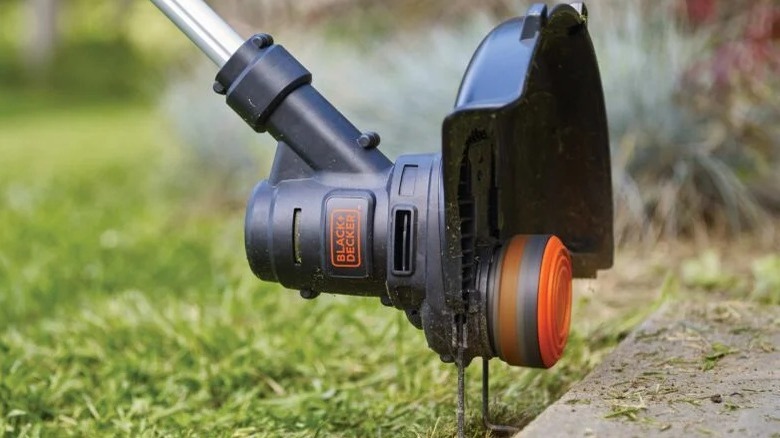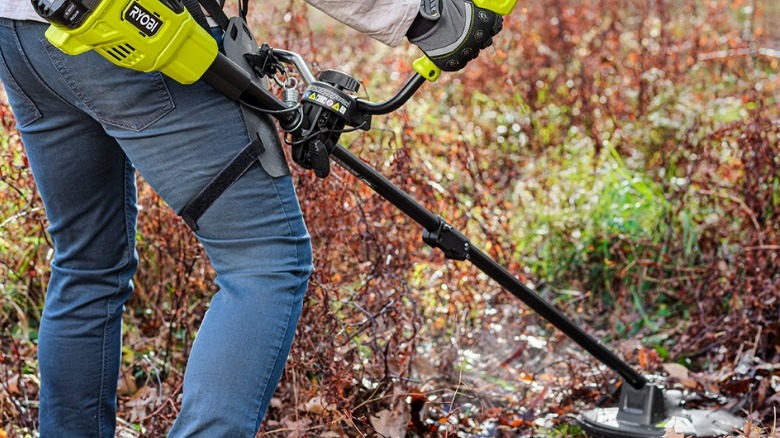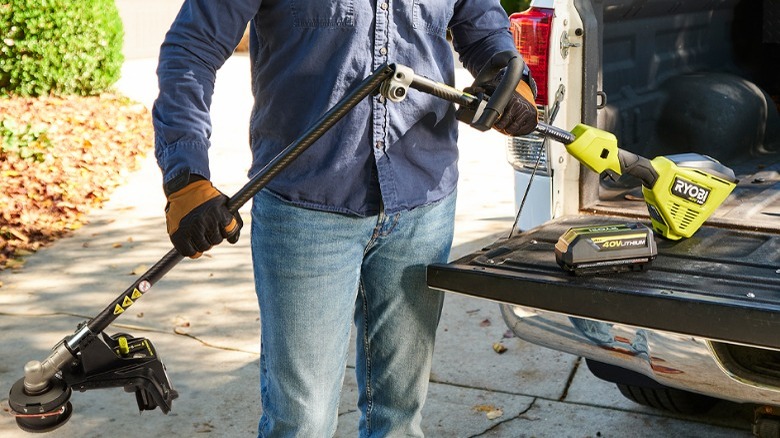Ryobi Vs. Black+Decker Weed Eaters: How Do These String Trimmers Compare?
We may receive a commission on purchases made from links.
A good weed eater is an important tool when it comes to yard care. Mowing might take care of a majority of your lawn's surface area, but there are always tough-to-reach areas where a mower simply won't go. There are a lot of different factors that you'll want to consider when choosing a weed eater, however, and price is pretty high up on the list for a lot of people.
Ryobi and Black+Decker are two brands that have both cultivated a strong reputation for providing quality tools at budget prices. Ryobi tools can primarily be found at Home Depot and from certain online retailers like Amazon. Meanwhile, Black+Decker tools are sold at most major hardware chains and can even be found at other big box stores like Walmart.
Both manufacturers are regularly counted among the best grass trimmer brands on the market, but you might be curious how they compare to each other. What do the product ranges look like, what powers them, what are the performance specs, what features are offered, how much is the cost, and what do professional reviewers think of them? Just about any of the weed eaters will come in handy when detailing your lawn, but here's a quick rundown of how these two rival brands' products stack up.
Ryobi has more variety
Ryobi and Black+Decker have massive catalogs and generally tend to offer more than one model for each kind of tool. This is no different when it comes to string trimmers. Both brands have a selection of different weed eaters, each with its own specs and features.
Ryobi currently has over 30 different string trimmers listed on its website. This is a truly massive selection, and there is a significant range in specifications. They also offer a variety of sizes and form factors. They range from 10 to18 inches in size. Most are dedicated string trimmers, but Ryobi also makes a couple of 2-in1 string trimmers/edgers, a trimmer/brush cutter, and it also has weed wacker attachments for its Expand-It system. These allow you to attach a string trimmer head to the Attachment Capable Power Head.
Black+Decker doesn't have quite as many string trimmers in its product line as Ryobi, but it's no slouch either. There are currently 24 string trimmers listed on the Black+Decker website. Also like Ryobi, these trimmers run on a wide range of sizes and form factors. They start at 10 inches and go up to 14 inches in size. There are standard string trimmers, trimmer/edger hybrids, and the company even makes a couple of 3-in-1 mower/trimmer/edgers that split apart in order to manage your whole lawn with a single tool.
Battery, electric, or gas?
Another thing to consider is how these tools are powered, as every system has its benefits and drawbacks. Battery-powered trimmers are convenient for smaller projects but require you to have a constant source of fully charged batteries for larger ones. Electric trimmers are powerful and easy to use, but require a long extension cord and keep you tethered to an outlet. Gas is powerful and cordless, but it's loud, produces fumes, vibrates more, and often requires more maintenance.
Most of Ryobi's trimmers are powered by the company's 18V and 40V One+ battery systems. The 18V batteries are commonly used for smaller hand tools, like drills, and are significantly less powerful than the larger 40V alternatives. The company makes corded electric and gas-powered models as well. This wide variety means that Ryobi fans will have plenty of options to choose from, but it will be particularly enticing for those who have already invested in the One+ battery system.
Most of the Black+Decker line is similar. The cordless units are all powered by the company's 20V Max and 40V Max battery systems. This promises a similar power output to Ryobi's One+ batteries as they have comparable voltage outputs and both battery lines are powered by lithium-ion cells. Black+Decker also sells corded electric models, though it doesn't appear that the company makes any gas-powered string trimmers at this time.
Comparing specs and features
Now that we've taken a look at the different kinds of string trimmers that Ryobi and Black+Decker offer, it's time to take a look at the performance metrics and features. One of the best ways to do that is to compare the specs from similar models between brands.
Starting with two of the lighter units. Ryobi offers a 13-inch String Trimmer and Edger Kit that includes an 18V 4.0Ah battery and charger. It weighs 6.9 pounds, runs .080-inch line, and has integrated LEDs. Ryobi promises, "a longer runtime or more aggressive cut with the adjustable 11" to 13" cut swath," though it doesn't specify how long that runtime actually is. It has an auto-feed head that advances the line as you pull the trigger. It also has a pivoting head and a wheel on the cut guard to easily convert the tool into an edger.
Black+Decker has a comparable 12-inch String Timmer/Edger that comes with two 20V 1.5Ah batteries and a charger. It weighs 8.3 pounds, uses .065-inch line, and allows you to choose between two speeds, giving you options between power and longevity. It has a button for releasing the line, a pivoting head and wheel, a PowerDrive transmission that increases torque. The big highlight between the two here, is that the Ryobi is quite a bit lighter.
We see a similar set of traits amongst the 40V models. The Ryobi comes with a 4.0Ah battery and promises up to an hour of runtime. It has a variable speed trigger as well as a bump feed head, and uses .080-inch line. The Black+Decker has a PowerCommand dial that allows you to adjust power output, a PowerDrive transmission, an automatic feed spool, and a two-hour full capacity fast charger. It also doubles as an edger and runs .065-inch line. However, Black+Decker does not specify the estimated runtime.
What reviewers have to say
Of course, it's always a good idea to take the manufacturers' listed specifications with a grain of salt and see what independent reviewers have to say. That way, you can get a better idea of how these tools perform in real-world conditions.
Kenny Koehler of Pro Tool Reviews took a look at both the 15-inch and 17-inch Ryobi 40V HP Brushless Carbon Fiber String Trimmers and seemed very impressed, giving the tools an overall rating of 9.4 out of 10. Koehler stated that both models were excellent. "If your needs are primarily trimming a maintained lawn, the 15-inch RY40290 is the better bet, " he said. "When you have larger acreage to maintain and tough, tall sections to reclaim, the 17-inch RY402110 has the muscle to give you the benefits of a battery-powered string trimmer with the performance of a legit gas model."
Meanwhile, The Garden Tool Review covered the Black+Decker 40V String Trimmer, and they seemed to like it as well. They praised the battery life, PowerCommand dial, and easy-to-handle design. "It's lightweight, easy to maneuver, doesn't have that incessant vibration that gas-powered ones do, and is comfortable to use."
Which is more affordable?
With any major tool purchase, you always have to consider the price. Both Ryobi and Black+Decker are typically known for being more affordable than most name-brand tool manufacturers, but you might be curious if one brand is even more budget-friendly than the other. Most of Ryobi and Black+Decker's products aren't perfect one-to-one matches, but the prices appear to be fairly comparable.
Starting with the electric models, Ryobi sells a 10 amp, 18-inch string trimmer for $86.96, while Black+Deckers closest model is a 7.5 amp, 14-inch trimmer which goes for $86.49 on Amazon. There is a slightly larger gap in the smaller battery-powered units. The 18V 13-inch Ryobi trimmer is $99, while the 20V, 12-inch Black+Decker trimmer is $93.28. As for the 40V models, Amazon sells Ryobi's stand-alone 12-inch trimmer for $99, and it has the Black+Decker 13-inch model for $81.
It seems that Black+Decker is a bit cheaper across the spectrum, but only by an extremely narrow margin. This makes it a lot easier for prospective buyers to simply purchase the tool they want, without having to worry too much about the difference in cost. Prices can vary much more widely when you take into account the inclusion of batteries of differing outputs and capacities, but the pricing scale for raw tools seems to be reasonably close across both brands.





